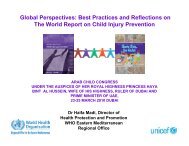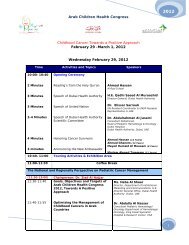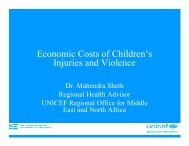Prof. Abdelbari Bener - Arab Children Health Congress
Prof. Abdelbari Bener - Arab Children Health Congress
Prof. Abdelbari Bener - Arab Children Health Congress
Create successful ePaper yourself
Turn your PDF publications into a flip-book with our unique Google optimized e-Paper software.
4 TH ARAB CHILDREN HEALTH CONGRESS<br />
THE NEED FOR GOOD DATA AND A<br />
SCIENTIFIC APPROACH<br />
FOR<br />
ACCIDENTS AND INJURIES: PREVENTION OF<br />
INJURIES AMONG CHILDREN<br />
Presented by<br />
<strong>Prof</strong>. Dr. Abdulbari <strong>Bener</strong><br />
<strong>Prof</strong>essor for Public <strong>Health</strong><br />
University of Manchester &<br />
Weill Cornell Medical College<br />
Hamad Medical Corporation
INTRODUCTION
INTRODUCTION<br />
• Injuries resulting from traffic collisions are a<br />
major cause of childhood death,<br />
hospitalization and disability throughout the<br />
world.<br />
• World <strong>Health</strong> Organization reported that<br />
around 10 million children annually are<br />
estimated to be injured or disabled as a<br />
result of road traffic injuries.<br />
• The exact proportion of children disabled by<br />
Road traffic injuries varies by age group and<br />
across countries.
INTRODUCTION<br />
• The exact proportion of children disabled<br />
by road traffic injuries varies by age<br />
group and across countries.<br />
• Globally, the road traffic death rate<br />
among children is 10.7/100,000<br />
population.<br />
• Road safety is of prime concern to many<br />
countries, all of whom require data and<br />
evidence.
CHILD RESTRAINT LEGISLATION BY<br />
COUNTRY/AREA
ROAD TRAFFIC INJURY MORTALITY RATES PER 100,000<br />
CHILDREN BY WHO REGION
DISTRIBUTION OF GLOBAL CHILD INJURY DEATHS<br />
BY CAUSE
PROPORTION OF FATAL ROAD TRAFFIC DEATHS AMONG CHILDREN<br />
BY TYPE OF ROAD USER IN SELECTED OECD COUNTRIES
THE CHILD INJURY DEATH LEAGUE
INTRODUCTION<br />
• Reliable data and evidence are essential<br />
for describing the burden of road traffic<br />
injuries, assessing risk factors,<br />
developing and evaluating interventions,<br />
providing information for policy makers<br />
and decision makers and racing<br />
awareness.<br />
• Without reliable data on accidents and<br />
injuries, the priorities for road traffic<br />
injury prevention cannot be rationally or<br />
satisfactorily determined.
INTRODUCTION<br />
• Data on the incidence and types of crashes<br />
as well as a detailed understanding of the<br />
circumstances that lead to crashes is<br />
required to guide safety policy.<br />
• However, in many countries, systematic<br />
efforts to collect road traffic data are not well<br />
developed and underreporting of deaths and<br />
serious injuries is common.<br />
• The health sector has an important role to<br />
play in establishing data systems on injuries,<br />
Road traffic accidents, effectiveness of<br />
interventions and communications of these<br />
data to a wide audience.
ROAD TRAFFIC INJURY AS A<br />
PUBLIC HEALTH PROBLEM
THE NEED FOR GOOD DATA<br />
FOR ACCIDENTS & INJURIES
THE NEED FOR GOOD DATA<br />
FOR ACCIDENTS AND INJURIES<br />
• An important element in dealing with child<br />
injuries is ascertaining the magnitude and<br />
characteristics of the problem..<br />
• A thorough understanding is needed, not only<br />
of the volume of child injury deaths, but also<br />
of :<br />
• the children who are most affected<br />
• the types of injury that are most prevalent<br />
• the geographic areas where the greatest<br />
problems are found
THE NEED FOR GOOD DATA<br />
FOR ACCIDENTS AND INJURIES<br />
• the particular risk factors<br />
• the child health policies, programs and<br />
specific injury interventions that are in<br />
place<br />
• standardized definitions are needed that<br />
are used across countries, not only for<br />
injuries but for disability as well.
THE NEED FOR GOOD DATA<br />
FOR ACCIDENTS AND INJURIES<br />
The following are the key reasons for<br />
collecting the data on accidents and<br />
injuries:-<br />
• overview the problem<br />
• monitor trends<br />
• identify high risk/problem groups<br />
• identify high risk, hazardous locations
THE NEED FOR GOOD DATA<br />
FOR ACCIDENTS AND INJURIES<br />
• enable objective planning and<br />
resource management<br />
• evaluate effectiveness and monitor<br />
achievement of targets<br />
• make international comparisons
POTENTIAL SOURCES OF DATA<br />
• The most two important potential sources<br />
for accidents and injury data are Police<br />
department data and hospital data.<br />
• However, in many countries a significant<br />
number of road crashes are not reported<br />
to the police.<br />
• The level of so called underreporting<br />
varies considerably from countries to<br />
countries.
POTENTIAL SOURCES OF DATA<br />
• Hospital data are an important source of<br />
information, especially about injury and<br />
treatment, but information relating to the<br />
scene of the crash is often missing in<br />
medical data.<br />
• For trend analyses and overviews of the<br />
accidents and injuries, it is recommended<br />
that both health and police records be<br />
examined. Direct matching of these two<br />
departments is always difficult in every<br />
country.
Country Specific Information System<br />
Key Source of Road Traffic Injury Data<br />
Source Type of data Comments<br />
POLICE<br />
• No. of road traffic<br />
incidents- fatalities<br />
and injuries<br />
• Type of road users<br />
involved<br />
• Age & Sex of<br />
causalities<br />
• Type of vehicles<br />
involved<br />
• Police assessment<br />
of causes of<br />
crashes<br />
• Varies from one<br />
country to another<br />
• Police records can<br />
be inaccessible<br />
• Underreporting is a<br />
common problem
Key Source of Road Traffic Injury Data<br />
Source<br />
<strong>Health</strong> settings<br />
• Hospital inpatient<br />
records<br />
• Emergency room<br />
records<br />
• Trauma registries<br />
• EMS records<br />
• Primary <strong>Health</strong> Clinic<br />
Type of data<br />
• Location of<br />
Crashes<br />
• Fatal and non<br />
fatal<br />
injuries<br />
• Age & Sex of<br />
causalities<br />
• Costs of<br />
treatment<br />
Comments<br />
• Level of detail varies<br />
from one health care<br />
facility to another<br />
• Injury data may be<br />
recorded under other<br />
causes, making it<br />
difficult to extract for<br />
analysis<br />
Insurance firms<br />
• Fatal and nonfatal<br />
injuries<br />
• Damage to<br />
Vehicles<br />
• Costs of claims<br />
• Access to these data<br />
may be difficult
Key Source of Road Traffic Injury Data<br />
Source<br />
Govt. departments<br />
and specialized<br />
agencies collecting<br />
data for national<br />
planning &<br />
development<br />
Type of data<br />
• Population<br />
denominators<br />
• Income &<br />
expenditure data<br />
• <strong>Health</strong> indicators<br />
• Exposure data<br />
• Pollution data<br />
• Literacy levels<br />
Comments<br />
• These data are<br />
complimentary &<br />
important for<br />
analysis<br />
of Road traffic<br />
injuries.<br />
• The data are<br />
collected<br />
by different<br />
ministries<br />
& departments
Key Source of Road Traffic Injury Data<br />
Source<br />
Special Interest<br />
groups<br />
• Research<br />
• Non Governmental<br />
• Transport authority<br />
Type of data<br />
• No. of road traffic<br />
incidents – fatal &<br />
non fatal<br />
• Type of road<br />
users<br />
• Age & sex of<br />
causalities<br />
• Type of vehicles<br />
involved<br />
• Causes<br />
•Location of crashes<br />
Comments<br />
• The various<br />
organization<br />
have different<br />
interests
APPROACHES TO DATA COLLECTION<br />
• Data on injury and its determinants are essential for<br />
identifying priority issues and high risk groups, and<br />
also for understanding the underlying causes of<br />
injury.<br />
• Agreement on the definitions of specific injuries is<br />
essential for accurate measurement and<br />
comparability.<br />
• The availability of good quality of data and of trained<br />
people to analyze such data are therefore important in<br />
the search for effective prevention interventions.<br />
• A lack of data can hold back action for want of<br />
evidence, prevent priorities from being correctly set,<br />
and hamper research and the evaluation of<br />
interventions
APPROACHES TO DATA COLLECTION<br />
• In developed countries, detailed analysis of sound<br />
data has undoubtedly been instrumental in achieving<br />
high rate of success in child injury prevention.<br />
• Data on child death and injury are generally either of a<br />
poor quality or missing<br />
• Discrepancies in data collected are sometimes used<br />
as excuses not to do anything, where they could<br />
instead serve as a foundation to strengthen<br />
information systems.<br />
• A major difficulty in child injury prevention is<br />
obtaining reliable estimates of the scale and pattern<br />
of child injury and death.
APPROACHES TO DATA COLLECTION<br />
• To this end, the volume, quality and availability of<br />
national and regional data needs to be increased<br />
through a combination of :<br />
• Better data collection systems<br />
• Improved surveillance<br />
• Use of hospital discharge systems including ICD<br />
external cause codes<br />
• More community based surveys on child injury<br />
using standard protocols
A SCIENTIFIC APPROACH<br />
FOR ACCIDENTS & INJURIES
A SCIENTIFIC APPROACH FOR PREVENTION<br />
OF ACCIDENTS AND INJURIES<br />
• Because of the complexity of road accident<br />
causation factors, the various organizations<br />
involved, and the emotional nature of road<br />
accidents, there is temptation to embark on<br />
policies and countermeasures that are visible<br />
but superficial and with little ultimate effect on<br />
the level of road safety.<br />
• It is essential that every developing country<br />
should have some local research activity on<br />
road safety issues to aid decision making.
A SCIENTIFIC APPROACH FOR PREVENTION<br />
OF ACCIDENTS AND INJURIES<br />
There are a number of scientific approaches to<br />
collecting and keeping data and evidence on road<br />
traffic injuries.<br />
1) INJURY SURVEILLANCE SYSTEM<br />
Country Specific Information system<br />
• Most countries have some form of national system for<br />
aggregating data on accidents and injuries using police<br />
records and or hospital records or both.<br />
• However, the quality and reliability of data vary between<br />
surveillance systems in different countries and also<br />
between systems within same country.<br />
• For road traffic injuries, certain key variables need to be<br />
collected<br />
• Countries should collaborate and help support regional<br />
and global systems so that the monitoring and<br />
evaluation of road safety can be improved and<br />
sustained.
A SCIENTIFIC APPROACH FOR PREVENTION<br />
OF ACCIDENTS AND INJURIES<br />
2) COMMUNITY BASED SURVEYS<br />
• A second approach to gathering data on road<br />
traffic injuries is to conduct community based<br />
surveys.<br />
• Some injured patients fail to reach hospital for<br />
variety of reasons and the hospital based injury<br />
surveillance system will not capture this type of<br />
cases.<br />
• But, community based surveys not only pick up<br />
these unreported cases, but also provide useful<br />
information on injuries and may be of particular<br />
relevance in countries where basic population and<br />
mortality data are not available.
A SCIENTIFIC APPROACH FOR PREVENTION<br />
OF ACCIDENTS AND INJURIES<br />
3) SURVEYS ON SELECTED THEME<br />
• A third approach is to conduct surveys on<br />
particular themes related to accidents and<br />
injuries.<br />
• These surveys may arise from the need for<br />
specific data that are not available from<br />
hospital based surveillance system or<br />
community surveys.
A SCIENTIFIC APPROACH FOR PREVENTION<br />
OF ACCIDENTS AND INJURIES<br />
4) HEALTH INDICATORS FOR ACCIDENTS AND INJURIES<br />
• Indicators are important tools not just for<br />
measuring the magnitude of a problem, but<br />
also for setting targets and assessing<br />
performance.<br />
• The preparation of health indicators face<br />
obstacles in data collected like errors in the<br />
population statistics and vehicle<br />
registration …etc .
A SCIENTIFIC APPROACH FOR PREVENTION<br />
OF ACCIDENTS AND INJURIES<br />
5) DEFINITIONS AND STANDARDISATION OF DATA<br />
• Road traffic injuries and death cases can<br />
be missed by the data collection system<br />
because of differences in the definition<br />
used in different countries.<br />
• There are a number of potential problems<br />
with the definitions of a road traffic death or<br />
injury arising from the following :-<br />
• Variations in the interpretation of the<br />
specified time period between the<br />
injury event and death.
A SCIENTIFIC APPROACH FOR PREVENTION<br />
OF ACCIDENTS AND INJURIES<br />
5) DEFINITIONS AND STANDARDISATION OF DATA<br />
• The actual interpretation of the<br />
definition in different countries and by<br />
different people recording the<br />
information.<br />
• Differing levels of enforcement of<br />
definitions<br />
• Differing techniques for assessing the<br />
severity of injuries
A SCIENTIFIC APPROACH FOR PREVENTION<br />
OF ACCIDENTS AND INJURIES<br />
6) DISSEMINATION AND APPLICATION<br />
• Road safety research is not an end in itself<br />
and findings need to be shared, discussed<br />
and applied in order for the full benefits to<br />
be realized.<br />
• Research institutes should publicize all<br />
results<br />
• Research findings can be also disseminated<br />
through seminars and training courses and<br />
international conferences.
CONCLUSION<br />
• Accident and injury data are a crucial<br />
element of a safety diagnosis.<br />
• An efficient road safety program must be<br />
based on these data, since realistic targets<br />
can only be established by using accident<br />
related information.<br />
• A standard data collection instrument<br />
should be developed by WHO so that all the<br />
countries will have uniformity in data<br />
collection.
THE KEY ORGANIZATIONS INFLUENCING<br />
POLICY DEVELOPMENT
THANK YOU







